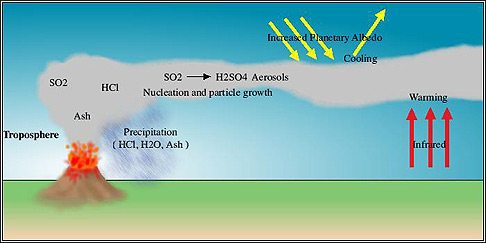There are affiliate links on this page. Read our disclosure policy to learn more.
 The eruptions considered
to be large enough to affect the Earth's climate on a scale of more than 1
year are the ones that inject over 0.1 Mt of SO2 into
the stratosphere.This
is due to the optical properties of SO2 and
sulfate aerosols, which strongly absorb or scatter solar radiation, creating
a global layer of sulfuric
acid haze.[41] On
average, such eruptions occur several times per century, and cause cooling
(by partially blocking the transmission of solar radiation to the Earth's
surface) for a period of a few years.
The eruptions considered
to be large enough to affect the Earth's climate on a scale of more than 1
year are the ones that inject over 0.1 Mt of SO2 into
the stratosphere.This
is due to the optical properties of SO2 and
sulfate aerosols, which strongly absorb or scatter solar radiation, creating
a global layer of sulfuric
acid haze.[41] On
average, such eruptions occur several times per century, and cause cooling
(by partially blocking the transmission of solar radiation to the Earth's
surface) for a period of a few years.
The eruption of Mount Pinatubo in 1991, the second largest terrestrial eruption of the 20th century, affected the climate substantially, subsequently global temperatures decreased by about 0.5 �C (0.9 �F) for up to three years. Thus, the cooling over large parts of the Earth reduced surface temperatures in 1991-93, the equivalent to a reduction in net radiation of 4 watts per square meter.[44] The Mount Tambora eruption in 1815 caused the Year Without a Summer.[45] Much larger eruptions, known as large igneous provinces, occur only a few times every fifty - hundred million years - through flood basalt, and caused in Earth past global warming and mass extinctions.[46]
Small eruptions, with injections of less than 0.1 Mt of sulfur dioxide into the stratosphere, impact the atmosphere only subtly, as temperature changes are comparable with natural variability. However, because smaller eruptions occur at a much higher frequency, they too have a significant impact on Earth's atmosphere.[40][47]
Seismic monitoring maps current and future trends in volcanic activities, and tries to develop early warning systems. In climate modelling the aim is to study the physical mechanisms and feedbacks of volcanic forcing.[48]
Volcanoes are also part of the extended carbon cycle. Over very long (geological) time periods, they release carbon dioxide from the Earth's crust and mantle, counteracting the uptake by sedimentary rocks and other geological carbon dioxide sinks. The US Geological Survey estimates are that volcanic emissions are at a much lower level than the effects of current human activities, which generate 100-300 times the amount of carbon dioxide emitted by volcanoes.[49] A review of published studies indicates that annual volcanic emissions of carbon dioxide, including amounts released from mid-ocean ridges, volcanic arcs, and hot spot volcanoes, are only the equivalent of 3 to 5 days of human caused output. The annual amount put out by human activities may be greater than the amount released by supererruptions, the most recent of which was the Toba eruption in Indonesia 74,000 years ago.[50]
-->